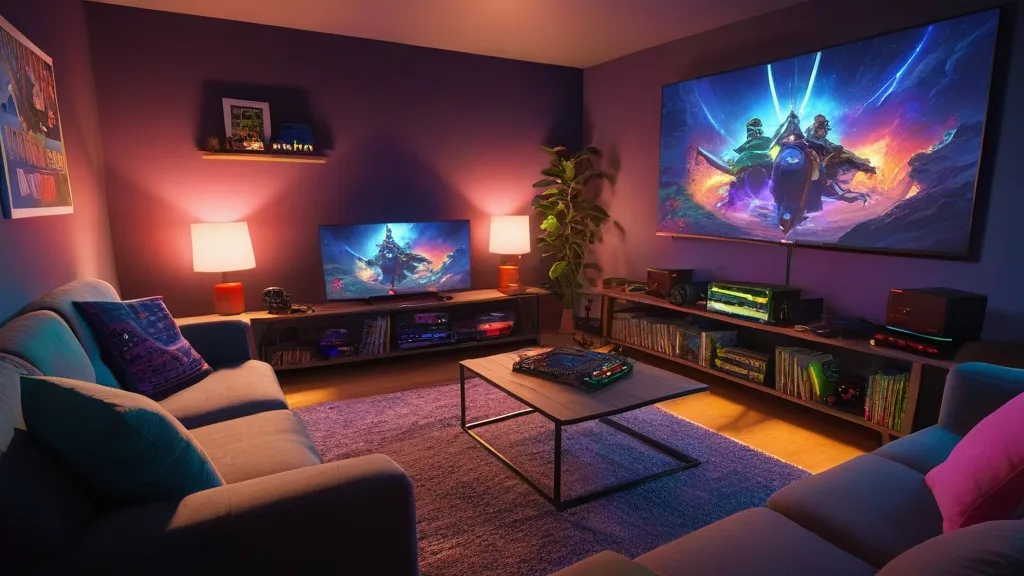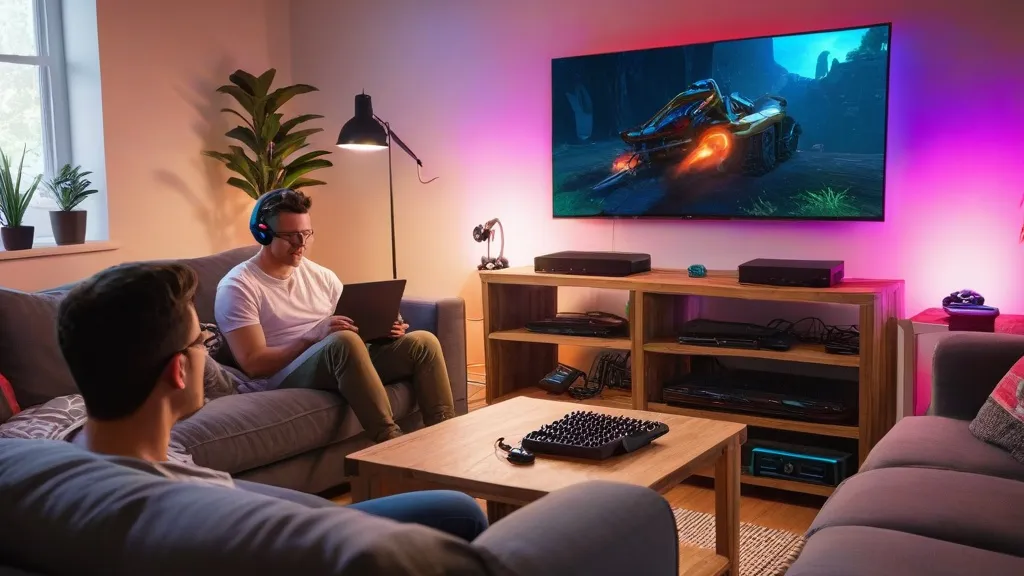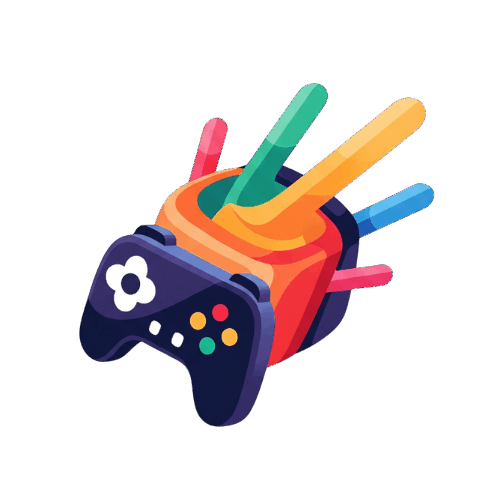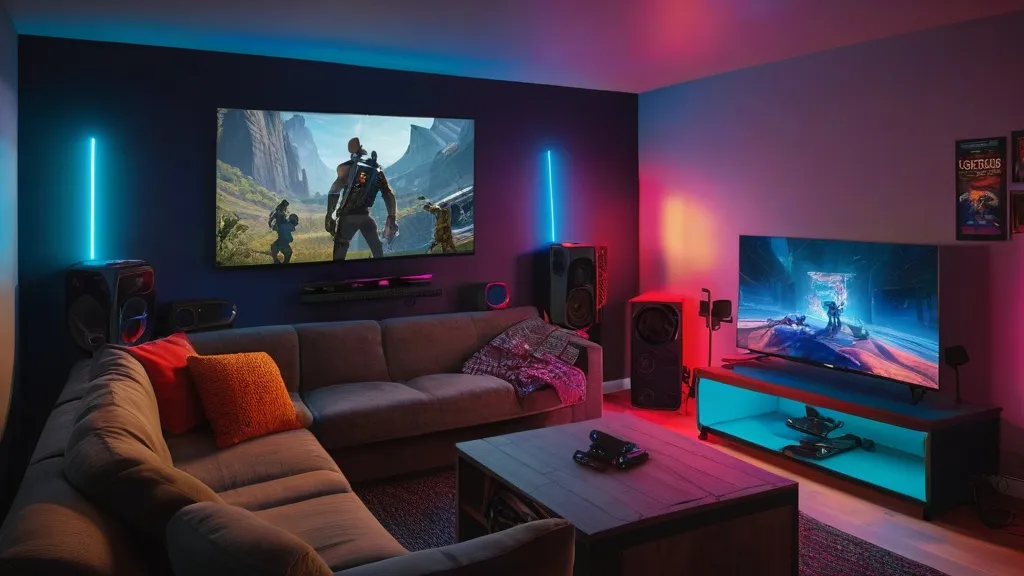I built my gaming room from a tragic dorm desk and a dream. A real gaming setup with RGB lighting, a console shelf, a PC build that sounds like a jet, and some lazy soundproofing. Cable management? I believe in miracles, not magic.
What this space is actually for

I treat the room like a weird mix of lounge, lab, and therapy booth. Play, yes. But also rest, movies, dumb snacks, friends yelling at each other over Mario Kart, and quiet single-player nights where I tinker with settings like a gremlin. If you want a label, it sits close to a home rec space—basically a modern recreation room but with more USB cables and fewer pool cues.
Big picture layout (start with the bones)
I’ve always found that the floor plan is the first boss fight. Measure. Draw a doodle. Then draw a second, worse doodle. Monitors need distance. Consoles need ventilation. Your chair needs to roll without crashing into a wall. I like a U-shape flow: desk and monitors in front, side table for controllers and snacks, and a small couch behind for co-op nights.
Do the social thing (sometimes)
In my experience, the room comes alive when people pile in. Four controllers. Pizza boxes. Chaos. I’ve watched shy friends turn into team captains during party games. If you want ideas for group nights, this piece on the community gaming craze nails the vibe—hilarity, team bonds, and the kind of epic fails we retell for months.
The ergonomics I wish I learned sooner
I used to hunch like a shrimp over a laptop. My back still remembers. Chair height matters. Desk depth matters. Monitor height matters. The stuff that sounds boring is the stuff that saves you.
If you want the official checklist on posture, monitor distance, and keyboard positioning, the OSHA computer workstation guide is oddly helpful. I know, government website. But it’s clear and practical.
Chair and desk basics
You don’t need a chair with neon piping and a scorpion tail. You need lumbar support, good foam, and a seat that doesn’t turn into a skillet after an hour. For desks, I like 30 inches deep at minimum if you’re running big monitors. If space is tight, clamp a keyboard tray under the desk and call it a day.
Screen height and distance
Top of the screen around eye level. Sit far enough back that you don’t feel like you’re risking a headbutt. An arm’s length to start, then adjust. Ultrawides want a bit more distance; TVs even more. Your eyes will vote with tears if you mess this up.
Lighting: the secret sauce people forget
Lighting is the difference between “cozy bunker” and “hostage video.” I like layered lighting: a dimmable overhead, bias lighting behind the monitor, and a floor lamp pointed at a wall for a soft bounce. The LEDs are vibes, sure, but they also reduce eye strain when your screen is the only bright thing in the room.
If you’re choosing bulbs, read up on efficient options here: LED lighting basics. TL;DR: they run cool, last long, and kill fewer brain cells than those cheap hot halogens from your garage.
One more thing—blue light. We all joke about “gamer eyes.” But late-night sessions do mess with sleep. A quick summary from Harvard on blue light’s dark side explains why your 3 a.m. scrolling habit is wrestling your melatonin. Night mode helps. So do warm lamps.
Theme or no theme?
I’ve seen clean, minimal rooms that feel like a sci‑fi lab. I’ve seen retro dens with a CRT shrine and a wall of cartridges. My own space sits somewhere between—neutral walls, warm wood desk, and an insulting number of tiny figures guarding my speakers. Pick one anchor: a color palette, a game series, or a single poster you love. Build around it.
Get inspired outside your house
I steal layout ideas from arcades, bars, and weird social clubs. Shelving tricks. Lighting tricks. Traffic flow. The tour of Slingshot Social Game Club gave me ideas for wall art placement and how to zone spaces without building a wall.
Sound: keep it rich inside, quiet outside
Acoustics don’t have to be fancy. Rugs help. Thick curtains help. A couple of foam panels in first reflection points helps. I stick a bookcase on a side wall because books are basically free diffusers with plot.
And your ears matter. Ask me how I learned. Long, loud sessions will bite. The NIDCD has a straight-shooting page on noise-induced hearing loss. It convinced me to cap volume and switch to open-back headphones for late nights.
Neighbors and roommates: the diplomacy
If your bass shakes the cutlery, you will receive texts. Keep subwoofers off the floor—put them on isolation pads or a little platform. Also, set a “quiet hours” window. Yes, you can still raid. Just… less explosion. Or use a tactile transducer on your chair for rumble without actual volume. Feels silly. Works great.
Budget tiers that actually work
Money talk. I’ve built on every budget—from milk crate era to “please don’t add up the receipts.” Here’s a quick and honest matrix I wish someone handed me years ago.
| Budget Tier | Core Desk Setup | Seating | Display | Audio | Lighting | Reality Check |
|---|---|---|---|---|---|---|
| Shoestring | Used desk, clamp tray, used monitor arm | Decent used office chair | Single 24” 1080p | Closed-back headset | One warm lamp + cheap LED strip | Focus on ergonomics first |
| Solid | 30” deep desk, quality arm | New ergonomic chair with lumbar | 27” 1440p 144Hz | Bookshelf speakers + DAC | Dimmable overhead + bias lighting | This is the sweet spot |
| Spicy | Corner desk or sit/stand rig | Premium ergo with adjustable armrests | Ultrawide or dual 27” | Studio monitors + interface | Smart zones, scenes, motion sensor | Don’t forget cable management |
| Absurd | Custom wood, hidden power channels | High-end ergo + guest couch | 77” OLED on wall + desk monitor | 5.1 with acoustic treatment | Automations tied to game launch | Showpiece. Also a money pit |
Noise control options (cheap to not-cheap)
| Option | Cost | Setup Difficulty | Effectiveness | Notes |
|---|---|---|---|---|
| Rug + pad | Low | Easy | Medium | Kills high-frequency echo |
| Heavy curtains | Low-Med | Easy | Medium | Great for windows and light control |
| Bookshelf “diffuser” | Low | Easy | Medium | Also looks smart. Fake it if needed |
| Foam panels | Low-Med | Medium | Medium | Place at first reflections, not everywhere |
| Door seals | Low | Easy | Medium | Huge improvement for cheap |
| Wall insulation | High | Hard | High | Overkill unless renovating |
A tiny rant about cable management
I’ve seen “after” photos that were clearly staged for five minutes and then collapsed. Real life has chargers, capture cards, a USB hub the size of a toaster, and that one mystery cable you’re afraid to unplug. My trick: power strip under the desk, adhesive raceways, and velcro loops. Also, label the big ones. Future you deserves mercy.
Controllers, remotes, and other gremlins
I keep a shallow drawer with dividers. One slot for Switch controllers, one for PlayStation, one for batteries, one for charging cables. The goal isn’t perfection; it’s getting your Saturday back because you didn’t spend an hour hunting for a charging cable shaped like every other cable.
Monitors vs TVs: pick your poison
For PC play, I like 27” 1440p at 144Hz as the happy middle. Big enough for immersion, crisp enough for text, fast enough for shooters. For couch play, a mid-size OLED is gorgeous but pricey. If you do both, a desk monitor plus a wall-mounted TV behind it gives you options. No more pushing the chair to the TV like you’re eight.
Console corner without the clutter
Vertical shelving near the TV. Enough airflow so your console doesn’t turn into a toaster. A small basket for remotes and a stand for headphones. Dock your controllers where you can see them charge. It’s all boring until it saves you time, then it’s magic.
Theme ideas from puzzle rooms
I steal ideas from escape room layouts for hidden storage and lighting cues. Colored light for “movie mode,” warm lights for reading, and a cool wash for focus. If you want to explore wild set designs, the guide to Orlando’s escape rooms is a rabbit hole of mood-setting.
PC build vs console rack (no wars, please)
I run both. Because I like having friends. PC gives you more control—keybinds, mods, wild performance tuning. Consoles win on simplicity and couch comfort. The room should flex for both: a good desk for mouse and keyboard, and a TV zone for controllers and long slouching.
Cooling and airflow
If the space gets hot during long sessions, I place a silent fan near the PC intake and keep a clear path out. Dust filters are your unsung heroes. Clean them when your frame rate starts sounding like it’s begging for help.
Power: don’t fry your dreams
Use surge protectors from real brands. Put the high-draw stuff on its own strip. Don’t daisy-chain a bunch of bargain-bin extensions like you’re wiring a treehouse. Also, label the kill switch for the desk. In a panic, you want one button to end the fireworks.
Research without going nuts
Whenever I fall into a gear hole, I try to curate my sources. For game-focused browsing and what’s trending, a roundup of top games feature sites is handy. I use lists like that to spot what people actually play before I plan storage or display.
For news and deep dives, I keep a few hubs pinned and skim weekly. This guide to gaming article hubs is a solid starting map. Saves time. Saves sanity.
Ambient stuff that makes the room feel finished
- Small plant (fake is fine). Breaks up the tech wall.
- Coaster. Your desk is not a science experiment.
- Cable pass-through grommet. Looks clean, feels pro.
- Wall hooks behind the door for bags and headsets.
- Microfiber cloth in a drawer. Screen smudges are chaos.
Hosting nights that don’t crash and burn
I set up a “party profile” on the PC and consoles: comfy volume, cross-play on, downloads paused, input lag settings trimmed. Snacks open, napkins nearby, extra Wi‑Fi password card on the shelf. It’s not fancy. It’s just less chaos.
Real talk: you don’t need everything
People assume I’m anti-fun because I say no a lot. But it’s the opposite. The quickest way to ruin a space is to cram it with every gadget on sale. Start with comfort. Then screen and sound. Then lighting. Then storage. Then… if you must… RGB. Which, yes, adds frames. Don’t quote me.
Inspiration beyond your bubble
When I hit a rut, I browse community builds and group spaces for layout ideas that survive real use. The post about the Slingshot Social Game Club (yep, I mentioned it before, it’s that good) sparked my idea for a small standing bar behind the couch. That tiny ledge? Peak snack utility.
Room setups for different players
- The single-screen focus goblin: one monitor, one lamp, one plant. Clean. Fast.
- The streamer corner: two monitors, camera on an arm, softbox, arm-mounted mic, rug to kill echo.
- The family den: TV + Switch dock + storage ottoman. Easy to reset after bedtime.
- The retro shrine: CRT on a rolling cart, HDMI switcher, labeled bins for carts. Respect the classics.
Health stuff I actually follow now

I take breaks. I stretch. I stop pushing through shoulder pain like it’s a side quest. This is the boring advice that keeps the hobby fun for years, not months.
Because I like to sleep, I run warm lights after 9 p.m. and dial down blue. The science-y version is here if you’re curious: blue light and sleep. Pair that with bias lighting behind your monitor and you’re golden.
I also set the room brightness a notch above the screen so my eyes don’t work overtime. It cuts fatigue during long sessions. Cheap fix. Big payoff.
My personal loadout (current)
- Desk: 60” x 30” with a simple cable tray.
- Chair: adjustable armrests, mesh back, lumbar support. Not a “racing seat.” I drive zero cars at my desk.
- Display: 27” 1440p 165Hz with a basic monitor arm.
- Speakers: tiny studio pair plus a headphone hook for late nights.
- Lights: overhead dimmer + bias strip + floor lamp for bounce.
When the room doubles as life
My space also hosts movie nights, work calls, and the occasional board game. That’s fine. Lean into it. Add a small folding table under the couch, a couple of stackable stools, and a basket for chargers. This isn’t a museum. It’s your space.
When to stop tweaking
At some point, you have to sit down and play. I set a rule: one tweak per week. If I still want it after seven days, it stays. If not, back to the bin. This protects me from chasing “perfect” forever.
Think of it like a toolkit, not a showroom
The best rooms I’ve seen look lived in. A little scuff on the desk. A controller charging. A coffee mug that should probably be washed. These are good signs. Means you’re actually using it. Not just posting it.
Old-school roots still matter
If you strip the LEDs and the screens, this is still just a place to hang out and play. You could call it a simple rec room and it wouldn’t be wrong. The tech is fun. The people are better. Even if the people are just you and your backlog.
One last plug for your eyeballs and ears
Backlighting behind the monitor and warm lamps help a ton, as does not blasting volume at 2 a.m. I remind myself with a note on the wall: “Fun tomorrow needs hearing today.” If you want the why, read about hearing loss from loud audio. Short read. Big impact.
Where group vibes meet at home
When friends drop by, I sometimes mimic arcade energy with mini challenges and silly tournaments. Getting ideas from the community gaming craze trend has made my nights oddly… organized? Still chaotic, but with rules. Which is the sweet spot.
Lighting nerd note, part two
LEDs aren’t just shiny candy. They’re efficient and flexible. I standardized on warm white plus a few accent colors. If you’re picking fixtures, this guide to LED lighting will keep you from buying the wrong brightness and calling me in a panic from aisle seven.
That word we started with
I’ve seen every kind of gaming room under the sun. Micro studio apartments crammed with love, big basements with sectional couches you could land a plane on, and everything between. The best ones keep it human. They bend around you. Not the other way around.
Side quest ideas
- Small pegboard for controllers and cables. Looks neat. Works better.
- Magnetic strip for screwdrivers and SD cards. No more desk hunting.
- Wall calendar for release dates you’ll ignore during a sale anyway.
- A “trade pile” box for old gear to swap with friends.
Random bits I swear by
Sticky notes. A microfiber cloth. A spare HDMI cable that lives in the drawer. A cheap air duster. Felt pads under everything so your desk doesn’t look like a cat fought it.
Theme nights are underrated
Rotate genres. Racing week. Puzzle week. Co-op campaign week. I got the idea after reading about themed venues and social hubs, like the write-up on Slingshot Social Game Club. It pushed me to think in zones, not just items.
Escape-room flair at home
I don’t rebuild a puzzle dungeon in my house, but I do borrow the mood. Low light. A prop map. Timer on the wall. The piece on Orlando escape rooms sent me down a theme rabbit hole that ended in… a vintage compass on my shelf. It sparks conversation. Also, it points north. Bonus.
Keeping up without drowning
I skim a curated set of top games feature sites when planning storage and playlist rotations. Then I peek at a guide to gaming hubs when I want deeper takes. Saves me from opening 47 tabs and forgetting why I started.
Safety-ish housekeeping
Check your cables twice a year. Toss the frayed ones. Vacuum the PC filters. Test the surge protector. Tighten the wall mount screws. Wipe your controller. Yes, wipe it. The science on sticky controller syndrome is thin, but my hands know.
Eye strain is real
I try to follow the 20-20-20 rule: every 20 minutes, look at something 20 feet away for 20 seconds. And I keep ambient light up so the screen isn’t a tiny sun in a dark cave. More nuance here on blue light effects if you want the deep dive.
Desk height, monitor distance—yep, again
I’m repeating myself. But that’s because it took me years to untrain bad habits. If you need a template, that OSHA workstation guide is weirdly solid for gamers too.
Why I still care after a decade
Because this little room holds a lot. Friends, stories, late-night wins, and the dumbest inside jokes. It’s where I reset after a long day. And it keeps evolving. New gear comes in; old stuff rotates out. The constant is how it feels when I sit down and the lights settle. That quiet “okay, let’s go.”
My last unasked tip
Print one photo of the room when you love it. Hang it somewhere. When the space starts drifting into clutter land, use the photo like a save point. Reload. It helps.
Anyway. I should probably dust the shelf goblins. And fix that one cable loop taunting me from under the desk. Tomorrow, maybe.
FAQs
- Do I really need an ergonomic chair, or is a cheap one fine? If you sit more than an hour a day, get the best chair you can afford. Your back will invoice you later if you don’t.
- Single monitor, ultrawide, or dual setup? If you play and study/work, dual 27” is flexible. If you mostly play and watch, ultrawide is immersive. Budget? Single 27” 1440p is the sweet spot.
- How bright should my room be when I play? Keep ambient light just below screen brightness. Add bias lighting behind the monitor. It reduces eye strain and makes colors pop.
- Is soundproofing expensive? It can be, but it doesn’t have to be. Start with rugs, curtains, door seals, and smart speaker placement. You’ll get 70% of the benefit for 20% of the cost.
- Do LEDs make my setup faster? Obviously. Everyone knows more RGB means more FPS. Kidding. They just make it feel nicer, which weirdly makes you play longer. So… kind of.

I’m Darius Lukas. On my blog, I break down what makes games tick with honest reviews, deep analyses, and guides to help you conquer your next virtual challenge.




Love the personal touch! Great tips for a cozy and functional gaming room setup. Happy gaming!
Great tips for creating the ultimate gaming room setup! Comfort and functionality are key. Thanks for the advice.
How do you maintain an optimal screen height and distance for long gaming sessions?